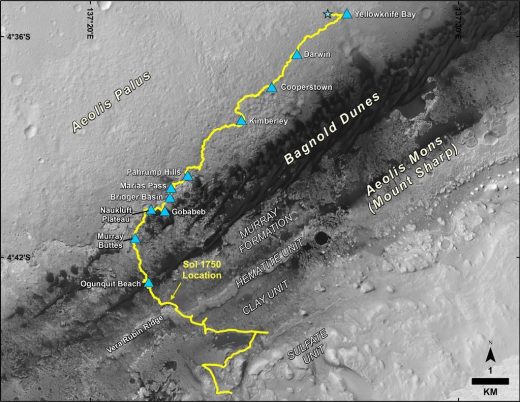The Cassini-Huygens mission ends on September 15th when the Cassini spacecraft will plunge into Saturn’s atmosphere. Looking back on the 13 years of exploring the Saturn system, the discoveries about Titan, on which the Huygens probe landed, were among the richest of the whole program: Cassini: The Grand Finale: Cassini Prepares to Say Goodbye to a True Titan
Saturn’s giant, hazy moon Titan has been essential to NASA’s Cassini mission during its 13 thrilling years of exploration there. Cassini and the European Huygens probe have revealed a fascinating world of lakes and seas, great swaths of dunes, and a complex atmosphere with weather – with intriguing similarities to Earth. Titan has also been an engine for the mission, providing gravity assists that propelled the spacecraft on its adventures around the ringed planet. For more about the Cassini-Huygens mission, visit https://saturn.jpl.nasa.gov
Over the course of its 13-year mission at Saturn, Cassini has made 127 close flybys of Titan, with many more-distant observations. Cassini also dropped off the European Space Agency’s Huygens probe, which descended through Titan’s atmosphere to land on the surface in January 2005.
Successes for Cassini during its mission include the revelation that, as researchers had theorized, there were indeed bodies of open liquid hydrocarbons on Titan’s surface. Surprisingly, it turned out Titan’s lakes and seas are confined to the poles, with almost all of the liquid being at northern latitudes in the present epoch. Cassini found that most of Titan has no lakes, with vast stretches of linear dunes closer to the equator similar to those in places like Namibia on Earth. The spacecraft observed giant hydrocarbon clouds hovering over Titan’s poles and bright, feathery ones that drifted across the landscape, dropping methane rain that darkened the surface. There were also indications of an ocean of water beneath the moon’s icy surface.
The instruments on Cassini allowed for seeing Titan in different ways: Cassini: The Grand Finale: Two Titans
These views were obtained with the Cassini spacecraft narrow-angle camera on March 21, 2017. Images taken using red, green and blue spectral filters were combined to create the natural-color view at left. The false-color view at right was made by substituting an infrared image (centered at 938 nanometers) for the red color channel.

More about the final days of Cassini: Cassini: The Grand Finale: Cassini to Begin Final Five Orbits Around Saturn.
====


